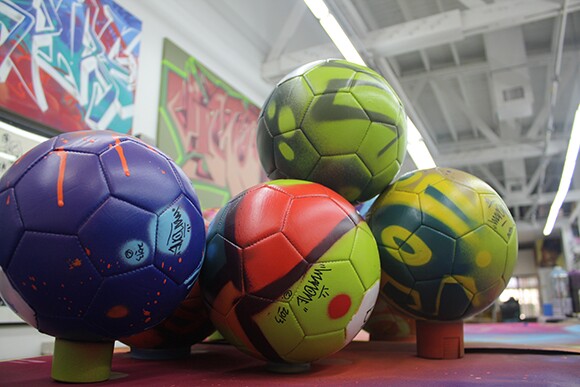Man One With One Man's Goal: Make Graffiti Legit

Man One was a tad behind in his mission to reconstruct the image of Los Angeles' urban art because his alter ego, family man and soccer dad Alex Poli, 43, was watching the World Cup. He still prepped by sketching out projects in his queue, but relief from his online followers came when the graffiti artist announced he would stop chatting up his teams and get back to posting his work online.
So it was back to the commissions that will add to his portfolio the texture and shape of writing, that like an abstract artist, he will change out if the letters can be read -- a metaphor of a graffiti artist wanting to be seen but not recognized. There's also work to be done in his bold colors of cubist-like portraits, graphic art capturing a subversiveness of his subject, even if it's Cesar Chavez or Self Help Graphic founder, Franciscan nun Karen Boccalero, two of the subjects in his temporary installations for METRO.
The portraits even translate into thoughtfulness if needed, like 2010's "They Claim I'm a Criminal" at the Southern California Library that feature CAPA and Mothers ROC as the central imagery, that at certain parts of the day shadows become part of the work by trapping faces, or be gone, the images freed until the next day.
But the distraction of watching competition was understandable since soccer was almost Man One's livelihood. As a 14-year old, his timing, footwork and balance as a goalie led to first of three recruiting attempts. He didn't take the steps to turn pro because going to Mexico was a risky venture at a young age, he said. And it was cultural irony considering how his dad managed to get into the U.S. "That would have been too weird," Poli said. "And I wanted to be an artist."
Other recruitment gestures came around the time he enrolled at Loyola Marymount University to study art. He stayed with it and Man One emerged while Alex played soccer entering his 30s, some of those earlier years played on semi-pro teams.

TIMING
He used those skills to get graffiti -- his and the works of others -- accepted in the mainstream gallery scene, and also now as the online version of Crewest grows as a business, you will see his inner-goalie rise up. During that time, I dropped in his gallery on those busy Art Walk nights, and asked him about the state of graffiti at various stages of crisis, he would square up his shoulders like he was getting set to defend, eyes glanced toward the gallery to see what chaos was shaping up, feet shifted in a back and forth soft rhythm ready to field any question.
In 2012, just past the 10 year mark, Man One closed Crewest Gallery, a mainstay in downtown Los Angeles since it's move from Alhambra to Winston Street in 2006. The final show was "Mission Accomplished," a poke at presidential war decrees and a nod that getting other graffiti artists noticed and slipped into the mainstream was a series of victorious battles. But he was taking on more work -- sponsored and private commissions -- to keep the doors open and leave the walls available for other artists. It was time for a change. Along with the mural on canvases, a lot of his inventory was backing up. "I don't have a specific exhibit but I was always creating new work," said Man One. "At the gallery it was hard to sell old inventory. I didn't want to take up wall space when new work is coming in."
The sluggish art market didn't help, and curating monthly themed shows left no time to sell his work, so he found dedicated studio space for his projects. It's been a rush of work since then. Besides taking on sponsored pieces, he has hosted international throw downs, given tours, and partnered in a communication agency with Scott Power.

FOOTWORK
He's also gone abroad to meet with other artists and survey the scene, and compare it to his Los Angeles/American style of getting graffiti art accepted. Since L.A. has the film industry, skateboards, and car culture -- which Man One has tapped into -- he was curious how others were managing to present graffiti as an art form. "I get commissioned to do all kind of stuff, all different kinds of things in L.A. I don't know how others do a living," he said.
"It's really weird what's happening about street art, especially in London."
For artists embedded in the cultural of royalty, where the value of work is determined by style that, if found, and stays with them as a career aesthetic. "In the U.K., it's like 'This is your style; stay to it.' They choose to do it that way, even if they aren't successful," he says.
"I was in conflict with some artists who are against street art photographers. There was a negative vibe. They look at street photographers like zombies. They can't think beyond the wall they are painting."

That's something he taught himself by asking others their thoughts about Twitter and Facebook, just around the time he was getting ready to announce the closing of Crewest Gallery. He was already using social networking to get the word out on exhibitions, but Man One wanted push it further. He found Instagram replaced his gallery just fine, and uses it to sell work, including posting up "Throwback Thursdays" to take his archive out of storage one piece at a time.
When he gives tours of murals in downtown Los Angeles, he borrows an idea from major museums that have exits through a gift shop. "It's a great way to market my work," he said. "It's like an audience that's hungry to hear about street art and mural and all that, and it ends at my studio."

BALANCE
Man One just makes it look easy. He's also an artist caught in the mural ordinance, sometimes frustrated by the process of permits complicated by the city recently, forced to make hard line requirements.
His first outing was smooth. A commission through the Mural Conservancy of Los Angeles, and help by MCLA's Executive Director Isabel Rojas-Williams, "They Claim I'm a Criminal" is the first mural to be restored under the mural ordinance and on the docket as legitimate. "I'm the first graffiti muralist to have a work be restored," said Man One.
And that's the ironic mark in Los Angeles art history, where graffiti has been a symbol of non-cooperation, despite its achievements as cultural markers of a movement. Man One has made graffiti part of the larger mural tradition that represents citizenship of a city, even if it means collaborating those impacted by the presence of his work. And it has him shift back and forth with revisions, a process that sometimes adds months to production.
A piece on 8th and Flower was the first entry for his "Faces of LA" series, that was planned to be a celebration of the mural ordinance and create portraits of every day people "away from the L.A. Celebrity." The first stages of funding was secured, "It took forever to get the sketch approved, then I went to get the permit..."
Man One is still reapplying paperwork. But to him, an artist who has been leading the graffiti into fine art scene -- including giving Former MOCA Chief Curator Paul Schimmel a late night tour of street art in 1994, years before "Art in the Streets," making it work is a needed step. "It makes it harder for a mural to be taken down," he said.
At a panel with other artists -- with others baffled by the permit process -- one undisclosed artist told the full house "fuck the ordinance," according to Man One. He then offered this idea: "Well, I'm tired of my murals getting painted over. If the only reason to get a permit is so that they can't buff you, I want to get a permit," he said. "All the other shit I will deal with, but I'm tired that murals are going down. It's harder to get up, but harder to go down."
Graffiti and the mural ordinance are in a transition phase, he says, but treating his methods like an art business, honoring business contracts is like developing a code of the street between art and commerce. By blocking all attempts for street art to fail in Los Angeles, he's still a goalie.




Dig this story? Sign up for our newsletter to get unique arts & culture stories and videos from across Southern California in your inbox. Also, follow Artbound on Facebook, Twitter, and Youtube.